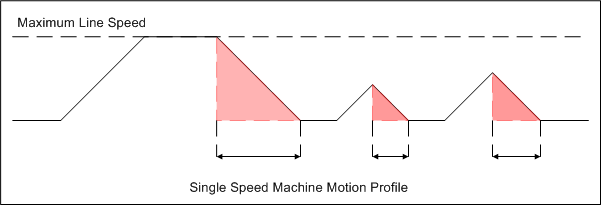Closed Loop Stopping
Closed Loop Stopping Key Features
- Very high accuracy
- Higher cost (servo system and associated components)
- Production rate depends on spacing of targets & dwell times
- Roll-feeder slip may require the use of second encoder
Closed loop stopping systems are similar to the open loop stopping systems but they can offer a much higher level of performance (both throughput and accuracy). Whereas an open-loop system’s accuracy depends largely on the repeatability of the equipment and consistent conditions, a closed loop system can provide great results regardless of these outside factors.
The motion profile of a closed loop stopping system is very similar to that of a single speed open loop system. The main difference is that the controller can accurately control the material movement so that as soon as the deceleration ramp is completed, the metal is positioned exactly under the desired punch or shear tool.

Closed loop feed-to-stop machines use servo systems to achieve very tight tolerances compared to other length control methods. Accuracy in this application is often ± 0.003” (0.08 mm) or better. Throughput is lower on stopping equipment since material must stop for press operations, but proper servo sizing based on the material load can help minimize the impact of stops.
The most common applications for closed loop stopping control are pre-punch systems where the hole-to-hole tolerance is critical or where flying punches would be impractical. Pre-punch/pre-cut operations are common on applications such as purlin machines. Because purlins can have such a wide range of profiles, it is more flexible to do all of the punching and cutting while the material is flat.
Movement of the material is typically accomplished through a roll feeder that pushes or pulls the material through the punch or cut presses. In some cases, both entry and exit roll feeders are used. The alternative to using a roll feed is to control the material position by moving the entire roll former. This can require a much larger servo system (vector drives are often used) since substantially higher inertia/mass must be driven.
Material Encoders
Since servos have their own feedback system, a system run by a servo motor is capable of extremely accurate positioning. Using the feedback of the servo motor in a feeder type of application can provide very good results on finished part tolerances, because the system is generally tracking the feed roll motion to ≈ 0.0002” (0.005 mm). Unfortunately, using the servo as the feedback for length control isn’t always practical. Slip between the powered feed rolls and the material surface is common. In these cases, a second, un-powered material encoder is required to maintain accuracy.
When the XL200CL controller is configured for two-encoder mode, the system will switch to close the position loop around the material encoder instead of the servo motor. For safety reasons, if the difference between the material encoder and the feedback from the servo motor grow too large (indicating excessive slip), the controller will halt the system with an error.
Loop Control
The following drawing shows a very typical machine configuration:

Closed Loop Stopping Pre-Punch + Roll Former + Flying Cut
The roll feed controls the material moving through the punch press. The punched material goes into a loop (sometimes with a deep pit) before running into the roll former. This loop is necessary since the roll former is moving at a constant speed while the feeder is constantly starting and stopping. The roll feed is normally designed to run at a much higher speed than the roll former. A good design is to have the worst-case throughput of the punching system be higher than the speed of the roll former. This prevents the loop from being pulled out by the roll former.
If the roll feed is running faster than the roll former, there needs to be something that prevents the loop from quickly filling up with metal. On the XL200CL controller, the FEED OK input provides that feature. This input is normally tied to the loop full sensor so that the controller will stop feeding material when the loop is full.
Machine Threading
Another feature of the XL200CL controller is the SLOW RUN input. This is typically used when loading a new coil. The material must be threaded through the punching presses and other machine elements. Rather than filling up the entire machine with metal before starting to punch (which would result in a machine initially full of scrap), it is possible to start punching the first part as the material is loaded by using the SLOW RUN input. As the name indicates, it is a run (automatic mode) input that puts the feeder at a jog speed instead of normal production speed. It is necessary that the proper safeguards and safety systems be put in place so that the operator is not in harm’s way during the loading process.
Summary
Closed loop stopping systems are very common solutions to achieving accuracy on punching applications. Although the initial equipment cost is higher than an open loop solution, the system is essentially immune to external conditions and requires no “tweaking” by the operator.